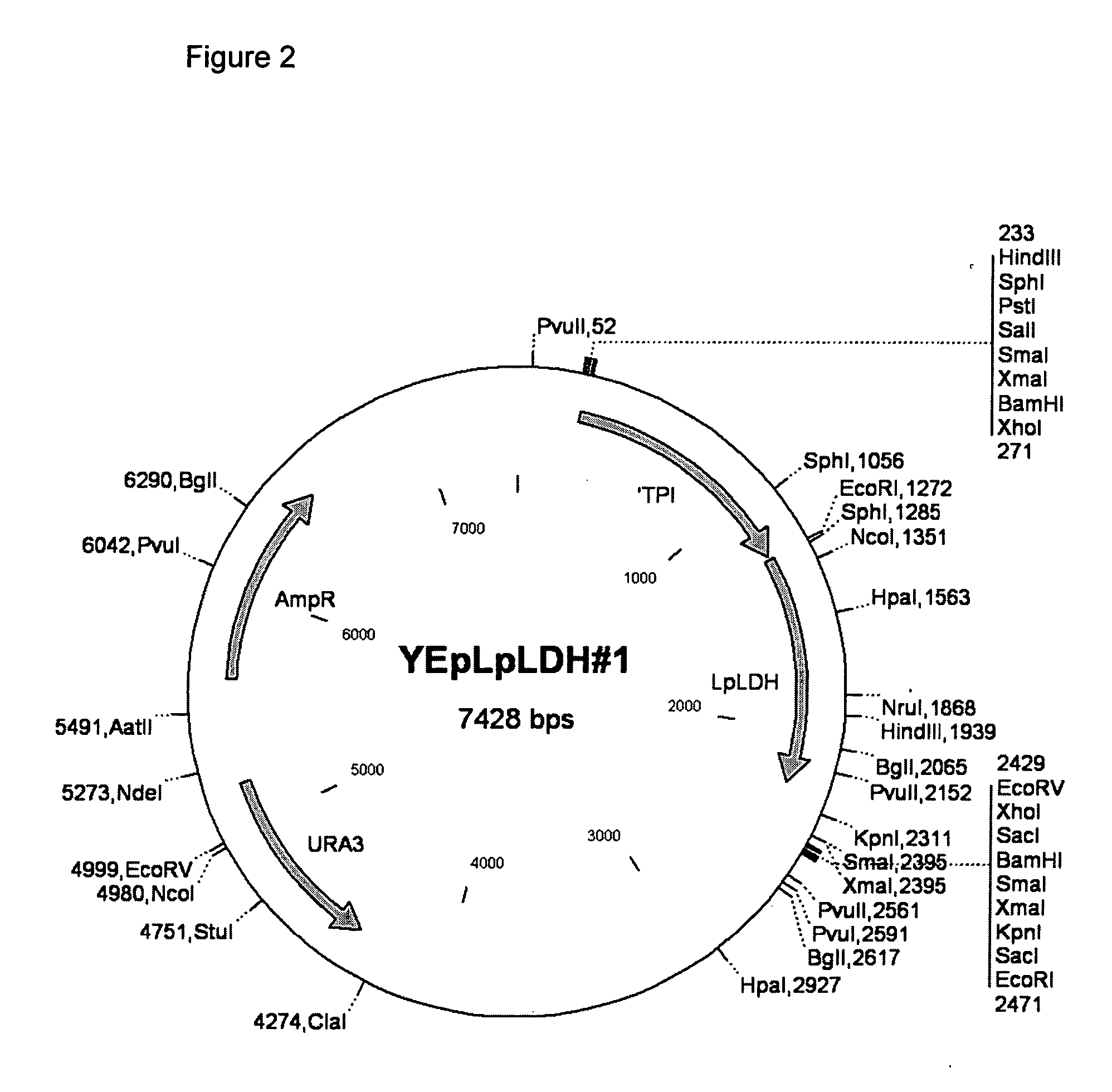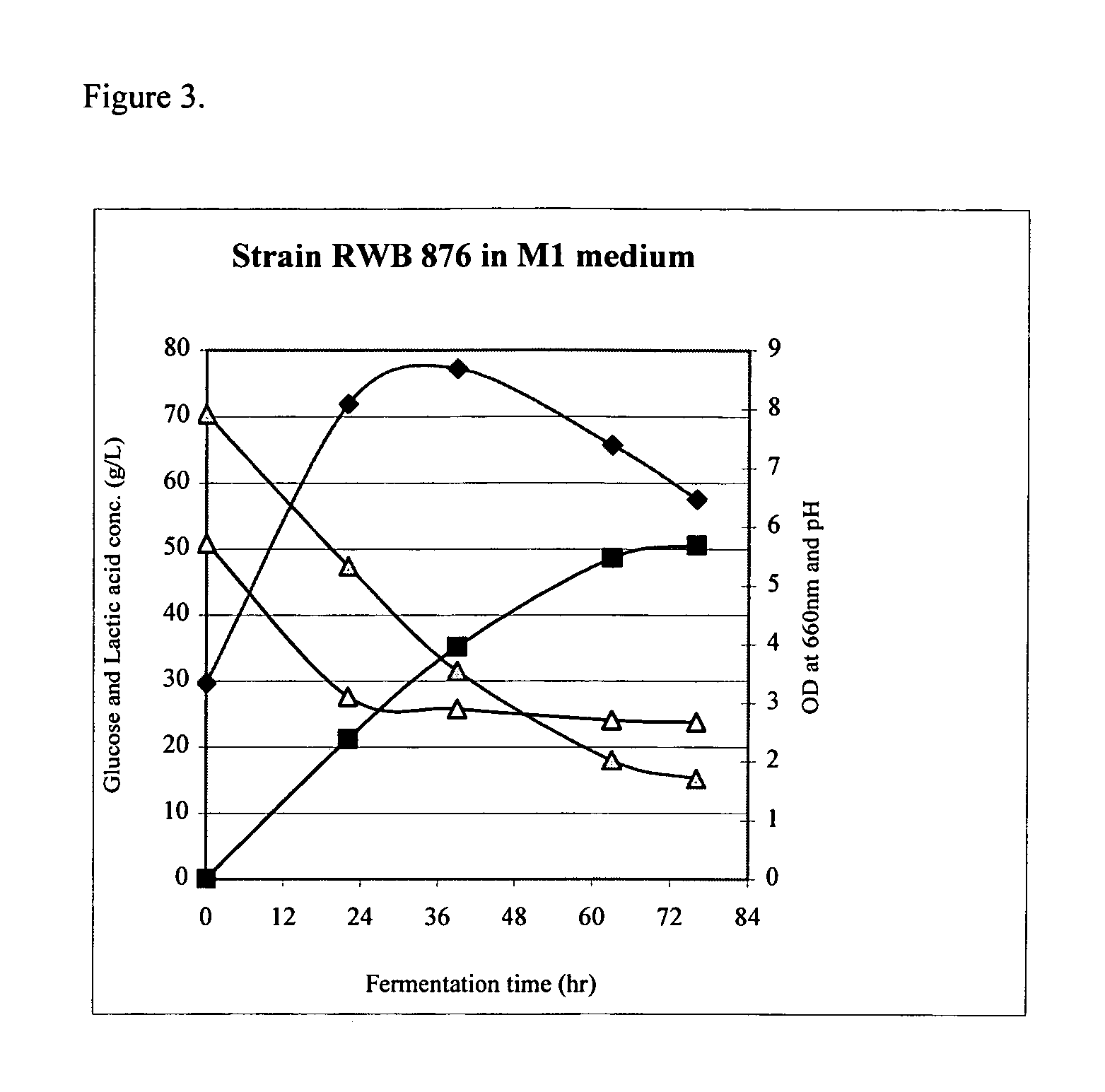Lactic acid producing yeast
a technology of lactic acid and yeast, applied in the field of yeast, to achieve the effect of cost-effectiveness
- Summary
- Abstract
- Description
- Claims
- Application Information
AI Technical Summary
Benefits of technology
Problems solved by technology
Method used
Image
Examples
example 1
Shake Flask Production of Lactic Acid in Chemically Defined Minimal Medium
[0099] Fermentations were carried out using strain RWB876, and M1 medium whose composition is listed in Table 2 below.
TABLE 2M1 Culture MediumCarbon SourcesGlucose70g / LEthanol0.5%Nitrogen Source and SaltsUrea1.0g / LKH2PO41.0g / LMgSO4.7H2O0.5g / LCaCO32.78g / LTrace element solutionCuSO4.5H2O62.5μg / LFeCl3200μg / LMnSO4.H2O450μg / LNa2Mo4.2H2O235μg / LZnSO4.7H2O712μg / LVitaminsBiotin2μg / LInositol2000μg / LThiamine HCl400μg / L
[0100] A 50% glucose stock solution was prepared and autoclaved separately from other components of the medium, and the glucose solution was ultimately added to the medium to obtain the final 70 g / liter concentration. Ethanol was added to the cooled autoclaved medium. A source of Ca+2 was used in the medium to better maintain the cells in an active, physiological stage. In this example, a total of 1112 ppm Ca+2 were added. The pH of the M1 medium was not adjusted.
[0101] The fermentations were carried ou...
example 2
Comparison of Fermentation by Acid-Tolerant Mutant, m850-a, and its Parent Strain RWB876
[0103] In this example the lactic acid production ability of the acid-tolerant mutant m850-a grown in M1 medium was compared to that of its parent strain RWB876. Fermentations were carried out in shake flasks in M1 medium using the conditions described in Example 1. Results are summarized in Table 3 below. The ability of the acid-tolerant mutant m850-a to continue growing at a pH less than about 3.0, allowed it to accumulate a higher concentration of lactic acid in its fermentation broth than its parent strain, RW876.
TABLE 3Fermentation of RWB876Fermentation of m850-aglu.lact.glu.lact.time (hr)ODpH(g / L)(g / L)ODpH(g / L)(g / L)03.345.7270.4003.365.7071.700228.093.1147.3621.247.183.0744.4523.78398.692.9031.5835.248.572.7825.8742.13637.392.7118.0248.659.312.657.5258.54766.472.6815.2350.569.002.603.3462.35
*glu. = glucose; lact. = lactic acid
example 3
Comparison of Acid-Tolerant Mutant, m850-a, with its Parent Strain RWB876 when Both are Grown in M1 Medium with an Initial Low pH
[0104] The experiment was carried out in shake flasks using M1 medium under the conditions described in Example 1, except that the initial pH of the medium was adjusted to 3.50 and no CaCO3 was added to the medium. The results are summarized in Table 4. Both strains were capable of initiating growth at pH 3.50 in the absence of CaCO3. At low pH, the acid-tolerant mutant, m850-a, demonstrated the ability to grow and to produce a higher concentration of lactic acid in fermentation broth than its parent strain.
TABLE 4Fermentation of RWB876Fermentation of m850-aglu.lact.glu.lact.time (hr)ODpH(g / L)(g / L)ODpH(g / L)(g / L)03.043.5073.8003.003.5073.500215.852.4357.0011.456.042.4156.4012.60316.542.3654.6116.356.762.3450.6118.24446.682.3450.4520.767.202.3145.4024.5268.56.672.3345.1224.128.162.2738.1630.3679.56.692.3343.6724.996.722.2736.1532.62
*glu. = glucose; lact. ...
PUM
| Property | Measurement | Unit |
|---|---|---|
| Length | aaaaa | aaaaa |
| Fraction | aaaaa | aaaaa |
| Fraction | aaaaa | aaaaa |
Abstract
Description
Claims
Application Information
 Login to View More
Login to View More - Generate Ideas
- Intellectual Property
- Life Sciences
- Materials
- Tech Scout
- Unparalleled Data Quality
- Higher Quality Content
- 60% Fewer Hallucinations
Browse by: Latest US Patents, China's latest patents, Technical Efficacy Thesaurus, Application Domain, Technology Topic, Popular Technical Reports.
© 2025 PatSnap. All rights reserved.Legal|Privacy policy|Modern Slavery Act Transparency Statement|Sitemap|About US| Contact US: help@patsnap.com



